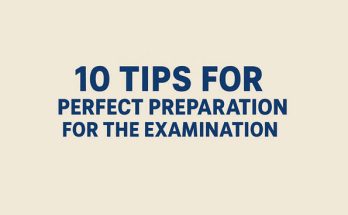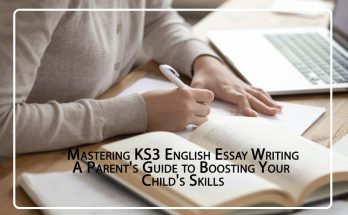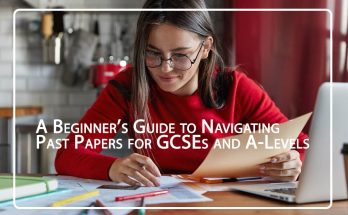Discover the top 10 study techniques that work — from active recall and spaced repetition to past paper practice and the Pomodoro method. Study smarter, not harder.
Whether you’re preparing for GCSEs, A-levels, university finals or other exams, studying smart is more important than simply studying hard. With so many techniques and strategies available online, it’s easy to get overwhelmed. That’s why we’ve compiled a list of the 10 most effective, research-backed study techniques — especially helpful when combined with past paper practice.

Let’s get started!
Active Recall
Active recall refers to the act of recalling information without looking at your notes. It is one of the most effective means to enhance memory and long-term retention.
How to use this
- When you have read a topic, close your book and see how much you can write.
- Make flash cards by writing questions on one side and answers on the other side.
- Do past paper questions without looking at your textbook.
Why it works: Retrieval fortifies memory circuits and identifies weak spots to review.
Spaced Repetition
Spaced repetition means reviewing material at longer and longer intervals as time passes, moments before you would forget them.
These tools may be worth a try:
- Download flashcard applications, like Anki or Quizlet.
- Develop a revision timetable (e.g. Day 1, Day 3, Day 7, etc.).
Why it works: It fights the forgetting curve and enhances long term memory.
The Pomodoro Technique
It involves dividing study time into short, concentrated periods (typically 25 minutes) with short breaks.
How to do it:
- Study 25 minutes (1 Pomodoro).
- Have a 5-minute break.
- Then, have a longer break (15 30 minutes) after 4 Pomodoro.
Why it works: It alleviates fatigue and assists in keeping concentration levels during studying.
Practice Past Paper
It’s not just a case of using past papers to guess what may appear on the exam paper again, it is about perfecting exam technique, how to gain maximum marks by knowing how the marks are allocated and about time management on the exam paper.
How to do it:
- Begin with open-book practice to develop knowledge.
- Move on to timed conditions to simulate the real exam.
- Look at and check the mark schemes to find out the grading of answers.
Why it works: It can help to develop confidence in the exam, decrease nerves, and can showcase common themes.
Interleaved Practice
What you can do is, instead of studying a single subject or topic exhaustively, say, for hours together, change the subject or topic in a single study session.
Example:
- 30 mins Biology → 30 mins English → 30 mins Maths.
Why it works: It enhances flexibility and boosts comprehension by diversification.
Feynman Technique
It is the act of describing a concept using extremely simple words like you are trying to teach that concept to a person.
Steps:
- Pick something that you would like to know.
- Put in words in a plain language explanation.
- Identify gaps in your knowledge.
- Fill those gaps by reviewing study materials.
- Repeat.
Why it works: Teaching obliges you to simplify and explain, and it shows how effectively you know your stuff.
Mind Mapping
Mind maps assist visual learners to organise and make links among information. They are excellent when there are a lot of interconnecting ideas in the topic.
How to make one:
- Begin in the centre with the major topic.
- Subtopics and keywords: branch out.
- Improve memory through use of colours, icons and images.
Why it works: Visual representation of relationships aids memory and aids revision of complicated subjects.
SQ3R Method (Survey, Question, Read, Recite, Review)
A methodical approach to reading that leads to improved understanding and retention.
Some stages of SQ3R
- Survey- skim headings and subheadings in the chapter.
- Question- Turn the headings into questions such as “What are the causes of climate change?”.
- Read- Try to find the answers to your questions.
- Recite- Put what you’ve learnt into your own words.
- Review- Go over the material again.
Why it works: It promotes active learning and engagement with the material.
Goal-oriented studying
When studying, develop specific and measurable goals instead of vague aims like “do some revision.”
Examples:
- “I will do 3 past paper questions from the 2022 GCSE Physics paper”.
- “I will make a mind map of the Cell Biology topic”.
- “I will revise and test myself with 20 French vocabulary flashcards”.
Why it works: Clear goals give purpose and help to keep revision on track.
Study in a Healthy Environment
Your environment can make or break your study session.
Tips:
- Study in a quiet, clean, bright room.
- Keep your phone on silent or use an app like Forest that will help you focus and limit phone distractions.
- Ask yourself if you have everything you need to study before you start (notes, pens, drinking water, etc..).
Why it works: A space free of distractions encouragingly helps you concentrate and make more efficient use of your study time.
Bonus tip: Mix and match for better effect.
These techniques are much stronger in mix with each other; for example:
- Combine spaced repetition with active recall using flash cards.
- Do past paper practice (i.e., retrieval practice) using the Pomodoro Technique.
- Use the Feynman technique to explain the content you have learnt using SQ3R.
Final Thoughts
Every person is different, and there is no universal way to study; however, these are some proven study tips that can give you a great start. Do what suits you, vary your routine when necessary and above all, incorporate regular practice, particularly with old exam papers. Now, keep in mind it is not studying more, it is studying smarter.



